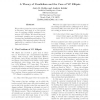Free Online Productivity Tools
i2Speak
i2Symbol
i2OCR
iTex2Img
iWeb2Print
iWeb2Shot
i2Type
iPdf2Split
iPdf2Merge
i2Bopomofo
i2Arabic
i2Style
i2Image
i2PDF
iLatex2Rtf
Sci2ools
ACL
1997
1997
A Theory of Parallelism and the Case of VP Ellipsis
We provide a general account of parallelism in discourse, and apply it to the special case of resolving possible readings for instances of VP ellipsis. We show how several problematic examples are accounted for in a natural and straightforward fashion. The generality of the approach makes it directly applicable to a variety of other types of ellipsis and reference. 1 The Problem of VP Ellipsis VP ellipsis has received a great deal of attention in theoretical and computational linguistics (Asher, 1993; Crouch, 1995; Dalrymple, Shieber, and Pereira, 1991; Fiengo and May, 1994; Gawron and Peters, 1990; Hardt, 1992; Kehler, 1993; Lappin and McCord, 1990; Pr¨ust, 1992; Sag, 1976; Webber, 1978; Williams, 1977, inter alia). The area is a tangled thicket of examples in which readings are mysteriously missing and small changes reverse judgments. It is a prime example of a phenomenon at the boundary between syntax and pragmatics. VP ellipsis is exemplified in sentence (1). (1) John revised hi...
| Added | 01 Nov 2010 |
| Updated | 01 Nov 2010 |
| Type | Conference |
| Year | 1997 |
| Where | ACL |
| Authors | Jerry R. Hobbs, Andrew Kehler |
Comments (0)

